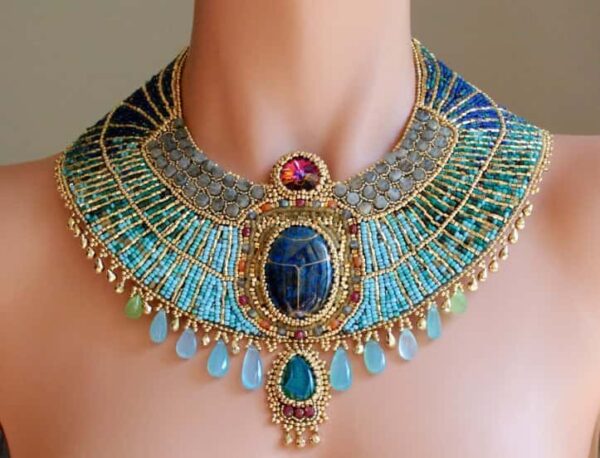
Top 4 symbols of Egyptian Jewelry
Egyptian jewelry is more than just adornment; it’s a reflection of a civilization that revered beauty, symbolism, and craftsmanship. From the vibrant collars of pharaohs to the intricate rings worn by queens, each piece of Egyptian jewelry tells a story of power, spirituality, and tradition. In this blog post, we’ll explore the fascinating world of Egyptian jewelry, diving into its historical significance, the materials and techniques used, and its enduring appeal in modern times.
A Glimpse into the History of Egyptian Jewelry
Egyptian jewelry has a history that spans thousands of years, dating back to the earliest dynasties around 3000 BCE. The ancient Egyptians believed that jewelry was not just for decoration but also held spiritual and protective qualities. This belief led to the creation of elaborate pieces that were often associated with the gods, the afterlife, and the wearer’s status.
Pharaohs and members of the royal family wore the most extravagant jewelry, often made from precious metals like gold and adorned with semi-precious stones such as turquoise, lapis lazuli, and carnelian. These materials were chosen not only for their beauty but also for their symbolic meanings. For instance, gold was associated with the sun god Ra and represented eternal life, while turquoise symbolized protection and health.
Jewelry was not limited to the elite; even commoners wore simpler pieces made from more affordable materials like copper and faience (a glazed ceramic). However, regardless of social status, the purpose of wearing jewelry remained the same: to protect the wearer, display their devotion to the gods, and signify their place in society.
The Symbolism Behind Egyptian Jewelry
One of the most intriguing aspects of Egyptian jewelry is the rich symbolism behind each piece. The ancient Egyptians believed that certain symbols could offer protection, bring good fortune, and ensure a successful journey to the afterlife. Some of the most common symbols used in Egyptian jewelry include:

- The Ankh: Representing life and immortality, the ankh is one of the most recognizable symbols in Egyptian culture. It was often worn as an amulet to protect the wearer and grant them eternal life.
- The Eye of Horus: Also known as the “Wadjet,” this symbol represents protection, health, and restoration. It was commonly used in amulets and rings to safeguard the wearer from evil spirits and misfortune.
- The Scarab Beetle: The scarab was a symbol of rebirth and regeneration, closely associated with the sun god Khepri, who was believed to roll the sun across the sky each day. Scarab amulets were worn to ensure safe passage to the afterlife.
- The Lotus Flower: Symbolizing purity, creation, and the cycle of life and death, the lotus was a popular motif in Egyptian jewelry. It was often used in necklaces and earrings, representing the wearer’s connection to the divine.
Craftsmanship and Materials: The Making of Egyptian Jewelry
The craftsmanship of Egyptian jewelry is nothing short of extraordinary. Ancient Egyptian jewelers were highly skilled artisans who used techniques that were advanced for their time. They employed methods such as casting, hammering, and soldering to create intricate designs that have stood the test of time.
Gold was the material of choice for most high-status jewelry, prized for its beauty and resistance to tarnish. It was often combined with colorful gemstones like turquoise, lapis lazuli, and carnelian, which were believed to hold protective and magical properties. These stones were inlaid into gold settings to create stunning pieces that glittered in the sunlight.
In addition to gold, the ancient Egyptians also used materials like silver, copper, and faience. Faience, a type of glazed ceramic, was particularly popular for creating beads and small figurines. It was affordable and could be produced in a variety of colors, making it accessible to a wider population.
Jewelry-making was a meticulous process that required precision and attention to detail. Artisans would often spend weeks, or even months, crafting a single piece, ensuring that every element was perfect. The resulting jewelry was not only a work of art but also a powerful symbol of the wearer’s beliefs and status.
Egyptian Jewelry in Modern Times
The allure of Egyptian jewelry has transcended time, continuing to captivate people around the world. The timeless designs and rich symbolism have inspired modern jewelry makers to create pieces that pay homage to ancient Egypt while incorporating contemporary elements.
Many modern pieces draw directly from ancient designs, featuring iconic symbols like the ankh, Eye of Horus, and scarab beetle. These symbols have been reimagined in sleek, minimalist designs or set with modern gemstones, making them accessible to a new generation of jewelry lovers.
In addition to traditional designs, some jewelers have taken inspiration from the colors and materials used in ancient Egyptian jewelry. Gold, turquoise, and lapis lazuli continue to be popular choices, creating a connection between the wearer and the ancient world.
Wearing Egyptian-inspired jewelry today is not just about fashion; it’s about embracing the history and culture of one of the world’s greatest civilizations. It’s a way to connect with the past, carrying the legacy of ancient Egypt into the present.
The Cultural Impact of Egyptian Jewelry
Egyptian jewelry has had a profound impact on the world of fashion and art. Its influence can be seen in everything from high-end jewelry collections to costume designs in movies and television. The opulent, gold-laden styles of the pharaohs have inspired countless designers, leading to a resurgence of interest in ancient Egyptian aesthetics.
also The fascination with Egyptian jewelry reached new heights during the 1920s, following the discovery of King Tutankhamun’s tomb. The treasures found within, including an array of stunning jewelry, sparked a global craze for all things Egyptian. This “Egyptomania” influenced everything from jewelry design to architecture, and its impact can still be felt today.
In popular culture, Egyptian jewelry continues to symbolize mystery, power, and timeless beauty. It’s often used to evoke a sense of the exotic and the ancient, transporting the wearer—and those who see it—back to a time of gods, pharaohs, and hidden treasures.
Why Egyptian Jewelry Still Matters
Egyptian jewelry is more than just a relic of the past; it’s a testament to the artistry and ingenuity of a civilization that valued beauty, symbolism, and spirituality. Each piece is a reminder of the beliefs and customs that shaped ancient Egyptian life, offering us a glimpse into a world that has long since vanished.
In a modern context, Egyptian jewelry allows us to carry a piece of that history with us, whether through a simple ankh pendant or a more elaborate scarab bracelet. It’s a way to honor the legacy of ancient Egypt, keeping its culture and traditions alive in a world that is constantly changing.
Whether you’re drawn to the symbolism, the craftsmanship, or the sheer beauty of Egyptian jewelry, there’s no denying its enduring appeal. It’s a connection to the past, a celebration of human creativity, and a timeless expression of the values that have defined civilizations for millennia.
Recent Posts
Edfu Temple :5 Reasons to Explore the Majestic Today
Discover 7 Amazing Features of Sinbad Hotel Egypt for 2024
Top 7 Reasons to choose Egypt Air Hospital in Egypt
All Categories
Tags

Thailand





